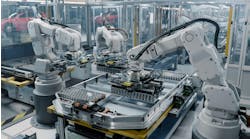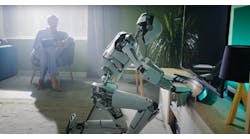Chris Cuomo said it—“the A word”—in a broadcast on CNN while talking about the trade tariff row in the early part of March. The A word is automation.
He was referring to the job market, and, regardless of the impact of the trade tariffs, jobs were not going to be created. But the major shareholders of the companies will benefit from the tariff-induced profits; if a steel mill were to come back on line, the jobs would be minimal.
True or not, it creates the conversation. I happen to agree with him. It’s about the money. It always has been and always will be.
The unemployment numbers have been fixed for a while now, according to businesspeople, because some people have dropped off the scale and are not being counted.
So, now we have a minimum-wage argument popping up. I have already talked about the ordering kiosks at fast-food restaurants to minimize chaos and streamline customer service. But, when you need to talk to someone sometimes, it is tough to find that person who can help you.
In Ontario, Canada, where I live, the minimum wage went to $15/hour overnight. It became a price point decision then. Wage numbers are x, and they will stay there. This means that an employee will make the same amount of money working less time, and customer service will suffer because of it.
And now California and its coffee shops will have the minimum wage increased to $15 by 2022. What will that mean? Time will tell, but I surmise that the baristas will be replaced by automation to appease the shareholders.
First case in point: Edward Rensi, former CEO of McDonald’s, stated that, if the minimum-wage issue permeated throughout the country, it will be cheaper to buy a 35,000 robot than to hire employees to do the tasks that a robot can do inexpensively and with far better consistency.
Second case in point: Caliburger has already started the trend. Check out Flippy, the Miso Robotics’ burger-flipping and -cooking robot. AI comes to life in a collaborative kitchen.
When robots first came into our world, there was a mantra about them never taking breaks, never asking for raises and never going on strike, which brings us to the social aspects of what has just started.
With fewer people doing the work, it is much easier to replace workers with robots, and I surmise that, if they organize or even if they are already organized, there is going to be a big fight on our hands since the union membership will have less and less bargaining power due to that shrinking membership.
This is how Flippy will work for now. A co-worker will place the burger patties on the grill. The end effector on Flippy is a flipper—thus, the name—and the robot monitors cooking times and temperatures. The temperature of the burger is measured by a thermal scanner. Regardless of the technology, the need for consistency is paramount, which is one of the reasons McDonald’s does so well in my view. Once Flippy cooks the burger on both sides, he notifies the co-worker and then picks up the burger and places it on the bun, which I assume has been toasted on the grill and moved to a delivery pan.
Flippy uses camera feedback to identify where the buns are and deposits the patty onto the bun using visual aids—linear and 3D—to position itself. A very cool flipper movement is utilized to do this.
The completion of the burger to order is done by the co-worker with such things as lettuce, tomatoes and condiments.
Very cool. And very similar to the pizza-making company, Zume Pizza, that utilizes robots to spread the dough and sauce, as well as tend to the pizza oven.
They are also utilizing onboard ovens in the delivery vehicles to cook the pizza so it arrives fresh.
Eatsa is another automated food-delivery company that has a California presence.
Caliburger, I’m sure, is eyeing the cost-saving attributes of Flippy. Where can you get the consistency of the finished product for such a low cost per unit? My good friend, Dick Morley, who recently died, often talked about point-of-sale manufacturing. You can do it with people or do it with automation.
Business has spoken, and it will be done with automation. With self-driving cars and trucks, a pizza or burger with fries is coming to a door near you, as fresh as it would be if you were at the counter ordering it yourself.
It is a fact that the low-wage jobs will be gone and in fact will die sooner than later with the help of our governments.
President Trump has started with Amazon to recover retail. I wish him luck. But just wait until we get IBM’s Watson on our phones.






